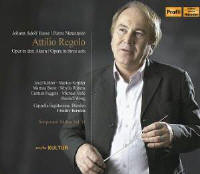Texte paru dans: / Appeared in: |
|
|
Outil de traduction (Très approximatif) |
|
|
Reviewer:
Richard Lawrence
The action, such as it is, concerns the efforts of the other characters to persuade Regolo to change his mind. There is a love interest, of sorts: Attilia, Regolo’s daughter, is mutually in love with the tribune Licinio; Amilcare, the Carthaginian ambassador, is mutually in love with Barce, who is also loved by Publio, Regolo’s son. But there are no love duets: in fact there are no duets or ensembles at all, the opera consisting entirely of recitatives and arias until the final Coro. What gets the opera into the history books are the accompanied recitatives, where the vocal line is punctuated by the strings: these and other aspects of characterisation were the subject of a famous letter from librettist to composer (October 20, 1749) that was surely intended for publication. The last scene is particularly effective, where Hasse moves three times from secco recitative to accompagnato and back. Given the seriousness of the subject, the arias are, on the whole, surprisingly jolly. The orchestration is plain: the violins are sometimes doubled by oboes or flutes, and a pair of horns puts in an appearance a couple of times. This 20-year-old concert performance from Dresden doesn’t exactly set the pulse racing. As Regolo, the part originally taken by the amusingly named Domenico Annibale, Alex Köhler gives little hint of the hero’s moral stature. Sibylla Rubens is too lightweight as Publio. On the other hand Michael Volle, now well known in Wagner and Strauss, is by no means overpowering in the role of Licinio. Martina Borst as Attilia, the part composed for Hasse’s wife Faustina Bordoni, is fluent in the melismas of her simile aria ‘Mia parea del porto in seno’; but the most winning performance comes from Carmen Fuggiss’s fresh-voiced Barce. The Cappella Sagittariana Dresden play springily for Frieder Bernius.
There are various cuts. The two
booklets contain contemporary illustrations, including costume designs, but the
layout is confusing and there are many errors (not just typos). The libretto is
given in Italian and German only. This is a useful stopgap but sceptics will
need something better to be convinced of Hasse’s genius. |
|




